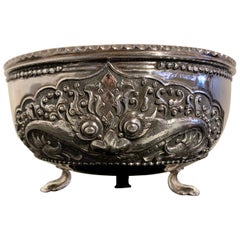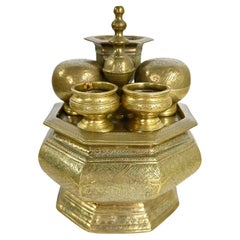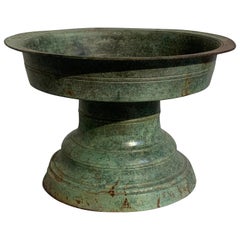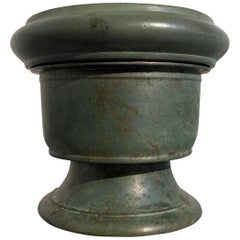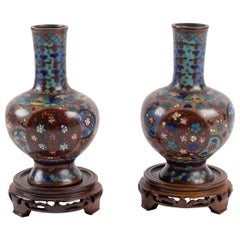Javanese Metalwork
to
4
4
2
2
2
1
4
2
1
1
62
1,517
1,121
619
460
4
4
4
Place of Origin: Javanese
Vintage Yogya Silver Kala Bowl by Tom's Silver, circa 1960's, Indonesia
Located in Austin, TX
A bold and well crafted Indonesian Yogya (Jogja, Djokja) silver bowl by Tom's Silver, Yogyakarta, Java, Indonesia, circa 1960's.
The elegant bowl features a striking design of a Kala face, a protective monster often found above temple doors, and representative of time, death, and rebirth. A pair of makara flank the wide open, smiling mouth. A stylized foliate design surrounds the Kala.
Kala are analogous with the Kirtimukha, or face of glory, originating in India and associated with Shiva. Both beings are devourers of evil and tasked with protection
The bowl features two beaded borders, and a scalloped rim.
The bowl set on three short out-swept feet.
Stamped mark to the underside reading "TOM" "800" "DELUX". TOM stands for Tom's Silver, perhaps the most famous silver workshop in Yogyakarta. 800 is the purity of the silver (80%). DELUX is a common mark on Yogya silver...
Category
1960s Vintage Javanese Metalwork
Materials
Silver
Vintage East Java Indonesian Brass Tepak Sireh Betel Nut Set 7 Pieces
Located in Topeka, KS
Phenomenal vintage East Java Indonesian brass Tepak Sireh betel nut set including a large brass bowl with removeable lid which doubles as a tray, two ...
Category
Mid-20th Century Anglo-Indian Javanese Metalwork
Materials
Brass
Central Javanese Bronze Footed Offering Vessel, 8th-10th Century
Located in Austin, TX
A gorgeously patinated bronze pedestal offering tray, talam, Central Javanese Period, Java, 8th-10th century.
The offering tray of beautiful form and proportions, with a splayed a...
Category
15th Century and Earlier Antique Javanese Metalwork
Materials
Bronze
Central Javanese Bronze Footed and Lidded Offering Vessel, 8th-10th Century
Located in Austin, TX
A stunning and rare Javanese bronze footed offering vessel and cover, Central Javanese Period, 8th-10th century.
The ritual offering vessel of elega...
Category
15th Century and Earlier Antique Javanese Metalwork
Materials
Bronze
Related Items
Khmer Bronze Hairpin
Located in Vosselaar, BE
Elegant and refined Khmer bronze hairpin dating between the 12th and 15th century.
Category
15th Century and Earlier Antique Javanese Metalwork
Materials
Bronze
Pair of Cloisonné Bronze Vases, Japan, Circa 1900
Located in Saint-Ouen, FR
Pair of cloisonné bronze vases, Japan, circa 1900, accident on one, slight depression
Measures: H 19cm, D 10cm.
Category
20th Century Japonisme Javanese Metalwork
Materials
Bronze
Japanese Bronze Vessel with Dragon Handles and Falcon Lid
Located in Greenwich, CT
Japanese bronze vessel with pair of dragon handles, falcon lid, birds in landscape and elephant heads base.
Category
1890s Meiji Antique Javanese Metalwork
Materials
Bronze
$3,500 Sale Price
27% Off
H 26 in W 12 in D 8 in
Japanese Meiji Period Sterling Silver 2 Handled Basket by Katsu Miyamoto
By Miyamoto Shoko 1
Located in Dallas, TX
PRESENTING a GORGEOUS, VERY HIGH QUALITY and EXTREMELY RARE piece of Japanese Meiji Period Sterling Silver 2 Handled Basket by Katsu Miyamoto.
EXQUISITE, EXCEPTIONAL, RARE & IMPORTANT!
This is definitely a Meiji Period piece due to the fact that it is marked with the sterling silver mark “jungin”.
The Meiji period was from 1868 to 1912 and in 1928 a law was introduced in Japan compelling the use of decimal marks for silver.
This pre-dates that decimalization law.
We are of the opinion that it is from circa 1900.
Miyamoto Shoko was founded in 1880 as the first silverware specialty shop. In 1899, Miyamoto Shoko’s silverwares were ordered by the family members of the Emperor of Japan, and to this day, they are making fine and graceful handicrafts with skillful craftsmen.
Loved by numerous customers since the Meiji era, Miyamoto Shoko’s products have also been given to Princess Mako and Princess Kako of Akishino, as well as Princess Aiko Toshinomiya, on their birthdays.
Katsu Miyamoto (宮本勝), in 1880, in order to increase the sales of tobacco and cigarettes to foreigners founded the Moyamoto Shoko company, which produced different silverwares in general and particularly silver cigarette cases. Miyamoto’s first name, Katsu (勝) in some sources is written as “Masaru”, since 勝 kanji can be pronounced in both ways.
This basket is of the HIGHEST QUALITY imaginable!
The top of the basket has the MOST GORGEOUS repousse work of flowers, probably lotus flowers, with leaves and foliage. It has an underlying chevron effect chasing, reflecting parquetry.
The 2 handles are cast in the form of bamboo handles.
The rim of the top likewise is cast as bamboo.
The base is equally stunning in a different way!
It is chased with a chevron effect, like parquetry flooring and the four feet simulate pieces of sliced bamboo with an interlinking gallery of support columns, likewise, simulating bamboo.
The QUALITY of WORKMANSHIP is OUTSTANDING!
The pieces weighs exactly 525 grams.
This piece takes my breath away!
This is one for the SERIOUS COLLECTOR of EXQUISITE AND RARE Japanese silver. You will not find another like it, for sale ANYWHERE ELSE IN THE WORLD …… I know as I have searched!
Provenance: Acquired from a Dallas Private Collector.
Dimensions: 9.6 inches wide, 7.6 inches deep and 2.75 inches tall ( 7.25 inches tall with handles up)
Condition: Very good. It looks like the base 4 legged gallery, has been repaired/re-attached to the base, but otherwise it is excellent and of Museum quality.
The Meiji period (明治時代 Meiji-jidai?), also known as the Meiji era, is a Japanese era which extended from October 23, 1868 through July 30, 1912.[1] This period represents the first half of the Empire of Japan during which Japanese society moved from being an isolated feudal society to its modern form. Fundamental changes affected its social structure, internal politics, economy, military, and foreign relations. The period corresponded with the reign of Emperor Meiji after 1868, and lasted until his death in 1912. It was succeeded by the Taishō period upon the accession of Emperor Taishō to the throne.
Solid silver pieces...
Category
Early 20th Century Meiji Javanese Metalwork
Materials
Sterling Silver
$7,250
H 7.25 in W 9.6 in D 7.6 in
Chinese Export Silver Goblet
Located in London, GB
A Chinese silver goblet profusely decorated with chased, richly defined chrysanthemum against a matte background and is supported by two intertwi...
Category
1890s Chinese Export Antique Javanese Metalwork
Materials
Silver
19th Century, Antique Burmese Bronze Elephant Bell with Stand
Located in Sampantawong, TH
Burmese bronze elephant bell with stand.
Age: Burma, 19th Century
Size: Height 12.5 C.M. / Width 9 C.M.
Size including stand: Height 23.5 C.M.
Condition: Nice condition overall...
Category
19th Century Antique Javanese Metalwork
Materials
Bronze
$384 Sale Price
20% Off
H 9.26 in Dm 3.55 in
Chinese Tobacco Water Pipe, c. 1900
Located in Jimbaran, Bali
Despite common belief that water pipes such as these were used to smoke opium, water pipes such as these were more commonly used for smoking Tobacco. The h...
Category
Early 20th Century Chinoiserie Javanese Metalwork
Materials
Brass
19th Century, Antique Burmese Bronze Cow Bell with Stand
Located in Sampantawong, TH
Burmese bronze cow bell with clapper inside with stand.
Age: Burma, 19th century
Size: height 7 cm / width 8 cm.
Size including stand: height 16.2...
Category
19th Century Antique Javanese Metalwork
Materials
Bronze
$256 Sale Price
20% Off
H 2.76 in W 3.15 in D 1.78 in
A Chinese Bronze Lidded Censer, 19th Century
Located in ARMADALE, VIC
A Chinese Bronze Lidded Censer, 19th Century
Provenance: Private Australian Collection.
Dimensons:
Height: 14cm.
Width: 13cm.
Depth: 9.5cm.
Category
19th Century Antique Javanese Metalwork
Materials
Bronze
12th Century, Angkor Vat, A Pair of Antique Khmer Bronze Hand Bells with Stand
Located in Sampantawong, TH
A pair of Khmer bronze hand bells with very nice patina.
Age: Cambodia, Angkor Vat Period, 12th Century
Size: Height 12.8 - 14 C.M. / Width 6.5 - 7.8 C.M.
Size including stand: Heig...
Category
15th Century and Earlier Antique Javanese Metalwork
Materials
Bronze
$1,072 Sale Price / set
20% Off
H 9.85 in Dm 3.08 in
Thai Bronze Buddha Head from the 9th/10th C, Museum Piece 8346
Located in Ukiah, CA
Very early Thai bronze Buddha head from the 9th/10thC. It has a sensitivity and finesse not often found in such early SE Asian sculptures. It ...
Category
15th Century and Earlier Antique Javanese Metalwork
Materials
Bronze
Early 20th Century, Showa, Japanese Bronze Vase
Located in Sampantawong, TH
Japanese bronze vase with nice form, used to decorate single flower arrangement in Japanese traditional tea ceremony.
Age: Japan, Showa Period, Early 20th Century
Size: Height 18.7 ...
Category
Early 20th Century Javanese Metalwork
Materials
Bronze
Recently Viewed
View AllMore Ways To Browse
Japanese Bronze Bowl
Gold Mirror Asian
Oriental Chargers
Chinese Silver Filigree
Mamluk Brass
Tibetan Repousse
Brass Arabic Coffee Pot
Bronze Chinese Stand
Chinese Hand Warmer
Cloisonne Tray
Copper Dallah
Copper Incense Burner
Japanese Kettle
Large Japanese Bronze Incense Burner
Namikawa Sosuke
Bronze Hibachi
Chinese Cloisonne Plate
Hammered Brass Plate India
